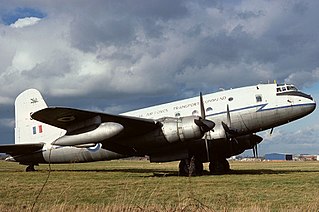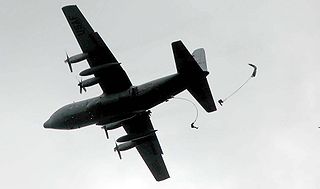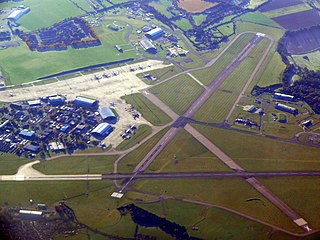
The Hawker Siddeley Nimrod is a retired maritime patrol aircraft developed and operated by the United Kingdom. It was an extensive modification of the de Havilland Comet, the world's first operational jet airliner. It was originally designed by de Havilland's successor firm, Hawker Siddeley; further development and maintenance work was undertaken by Hawker Siddeley's own successor companies, British Aerospace and, later, BAE Systems.

The Red Arrows, officially known as the Royal Air Force Aerobatic Team, is the aerobatics display team of the Royal Air Force (RAF) based at RAF Waddington. The team was formed in late 1964 as an all-RAF team, replacing a number of unofficial teams that had been sponsored by RAF commands.

The Avro York was a British transport aircraft developed by Avro during the Second World War. The design was derived from the Avro Lancaster heavy bomber, several sections of the York and Lancaster being identical. Due to the importance of Lancaster production, York output proceeded slowly until 1944, after which a higher priority was placed upon transport aircraft.

On 2 June 1994, a Chinook helicopter of the Royal Air Force (RAF), serial number ZD576, crashed on the Mull of Kintyre, Scotland, in foggy conditions. The crash resulted in the deaths of all twenty-five passengers and four crew on board. Among the passengers were almost all the United Kingdom's senior Northern Ireland intelligence experts. The accident is the RAF's fourth-worst peacetime disaster.

The Boeing Chinook is a large, tandem rotor helicopter operated by the Royal Air Force (RAF). A series of variants based on the United States Army's Boeing CH-47 Chinook, the RAF Chinook fleet is the largest outside the United States. RAF Chinooks have seen extensive service in the Falklands War, the Balkans, Northern Ireland, Iraq, and Afghanistan.

The Vickers VC.1 Viking is a British twin-engine short-range airliner derived from the Vickers Wellington bomber and built by Vickers-Armstrongs Limited at Brooklands near Weybridge in Surrey. After the Second World War, the Viking was an important airliner with British airlines, pending the development of turboprop aircraft like the Viscount. An experimental airframe was fitted with Rolls-Royce Nene turbojets and first flown in 1948 as the world's first pure jet transport aircraft. Military developments were the Vickers Valetta and the Vickers Varsity.
The history of the Royal Air Force, the air force of the United Kingdom, spans a century of British military aviation.

On 2 September 2006, a Royal Air Force Hawker Siddeley Nimrod suffered an in-flight fire and subsequently crashed in Kandahar, Afghanistan, killing all fourteen crew members on board. The crash, which occurred during a reconnaissance flight, was the biggest single loss of life suffered by the British military since the Falklands War.

The Lockheed Martin C-130J Super Hercules is a four-engine turboprop military transport aircraft. The C-130J is a comprehensive update of the Lockheed C-130 Hercules, with new engines, flight deck, and other systems.

On 6 June 1982, during the Falklands War, the British Royal Navy Type 42 destroyer HMS Cardiff engaged and destroyed a British Army Gazelle helicopter, serial number XX377, in a friendly fire incident, killing all four occupants. Cardiff, on the lookout for aircraft flying supplies to the Argentine forces occupying the Falkland Islands, had misidentified the helicopter as an enemy C-130 Hercules. Although the helicopter's loss was initially blamed on enemy action, a subsequent inquiry found Cardiff's missile to be the cause.

The Little Baldon air crash occurred on 6 July 1965 when a Handley Page Hastings C1A transport aircraft operated by No. 36 Squadron Royal Air Force, registration TG577, crashed into a field in Little Baldon, near Chiselhampton, Oxfordshire, shortly after taking off from RAF Abingdon. The flight was captained by Flt Lt John Akin. All 41 people aboard, including six crew, perished in the crash, making it the third worst air crash in the United Kingdom at the time.

The 1948 Northwood mid-air collision took place on 4 July at 15:03 when a Douglas DC-6 of Scandinavian Airlines System (SAS) and an Avro York C.1 of the Royal Air Force (RAF) collided in mid-air over Northwood in London, UK. All thirty-nine people aboard both aircraft were killed. It was SAS's first fatal aviation accident and was at the time the deadliest civilian aviation accident in the UK. It is still the deadliest mid-air collision in British history.

On 9 November 1971, a Royal Air Force Lockheed Hercules C.1 crashed into the sea off the coast of Livorno by Meloria shoal, Italy, killing all 46 passengers and 6 crew. At the time it was described by Italian officials as the worst military air disaster in Italy in peacetime.

Royal Air Force Lyneham otherwise known as RAF Lyneham was a Royal Air Force station located 6.3 miles (10.1 km) northeast of Chippenham, Wiltshire, and 10.3 miles (16.6 km) southwest of Swindon, Wiltshire, England. The station was the home of all the Lockheed C-130 Hercules transport aircraft of the Royal Air Force (RAF) before they were relocated to RAF Brize Norton.

The Dunbeath air crash involved the loss of a Short S.25 Sunderland Mk. III that crashed in the Scottish Highlands on a headland known as Eagle's Rock near Dunbeath, Caithness, on 25 August 1942. The crash killed 14 of 15 passengers and crew, including Prince George, Duke of Kent, who was on duty as an Air Commodore in the Royal Air Force on a mission to Reykjavík; a message of condolence was proposed in Parliament by the British Prime Minister. A Royal Air Force Board of Inquiry determined that the crash was the result of a navigational error by the crew.

On 30 April 1990, a Royal Air Force Avro Shackleton AEW Mk II aircraft, of No. 8 Squadron RAF, based at RAF Lossiemouth, crashed into a hill on the Isle of Harris whilst attempting to land at RAF Benbecula. All ten crew on board died in the crash, which included the wing commander who was in charge of No. 8 Squadron at the time. The Shackleton was the last of the fleet to be involved in a fatal accident, and the type was withdrawn from RAF service in 1991.















